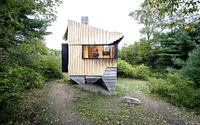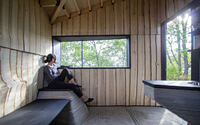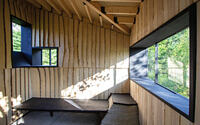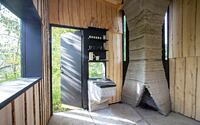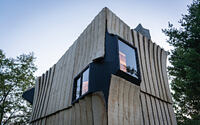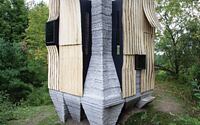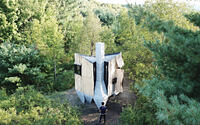Ashen Cabin by Hannah
Introducing the innovative Ashen Cabin, a marvel of futuristic design located in the serene landscapes of upstate New York. Crafted by HANNAH, the ingenious design firm run by assistant professors of architecture Leslie Lok and Sasa Zivkovic from Cornell University, this architectural jewel stands as a testament to their groundbreaking response to environmental crisis.
Seamlessly blending robotic technology and 3D printing in timber and concrete construction, this cabin explores the future of home construction. But what’s truly remarkable is its unique approach to sustainability: it’s built from ash trees devastated by the Emerald Ash Borer beetle, an invasive species threatening nearly one in ten Ash trees in New York state.
Step inside to discover the intricate process behind the creation of this avant-garde cabin that’s redefining sustainability and residential design in America.

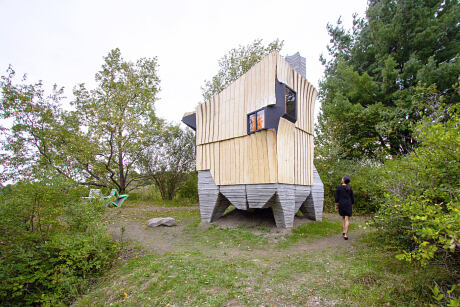
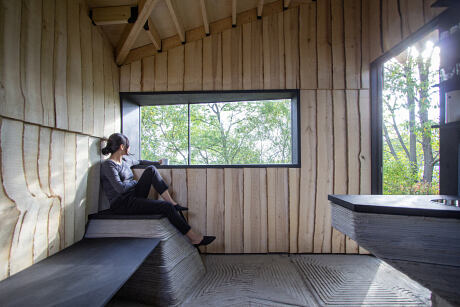
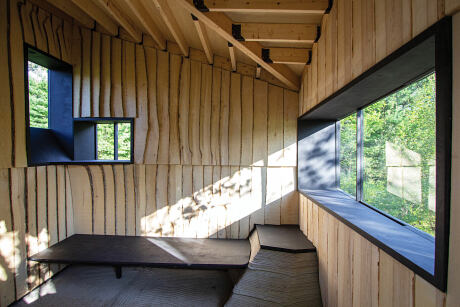

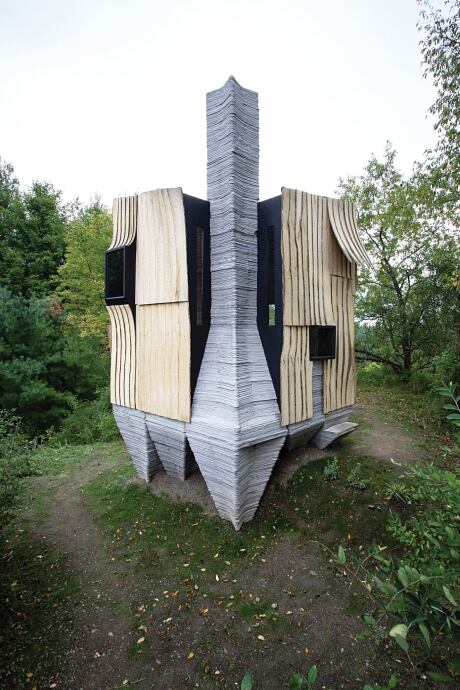

About Ashen Cabin
Emerald Ash Borer Crisis Sparks Innovation at Cornell University’s College of Architecture, Art, and Planning
Cornell University’s College of Architecture, Art, and Planning is taking a crucial step in response to the Emerald Ash Borer beetle, an invasive species that’s laying waste to native Ash trees throughout the nation. Believed to have been introduced via human trade and travel in the summer of 2002, the Emerald Ash Borer now poses a threat to 8.7 billion trees across the country, including nearly one in ten Ash trees in New York state.
Leslie Lok and Sasa Zivkovic, assistant professors of architecture at Cornell and co-principals of their design firm, HANNAH, are at the helm of this creative response. They’ve designed and built a full-scale prototype cabin in rural Upstate New York. This eco-friendly cabin isn’t just a reaction to the environmental crisis; it’s a demonstration of technological advancements in architecture, such as robotics and 3D printing in timber and concrete construction.
The Unforeseen Benefit of Dying Ash Trees: A New Source of ‘Waste Material’
Traditionally, mature ash trees compromised by the Ash Borer haven’t been usable as a source of lumber for home construction due to their irregular geometries. However, Lok and Zivkovic are challenging this norm. They argue that using compromised ash for construction binds carbon to the earth, offsetting the harvesting of more commonly used wood species, and mitigating the release of CO2 into the atmosphere that results from burning or decomposition.
Robotic and 3D-Printed Concrete Technology: Paving the Way for Sustainable Construction
Lok and Zivkovic have harnessed advancing technologies, notably robotics and 3D printed concrete, to make the use of infested ash trees possible. At the Robotic Construction Lab (RCL) at Cornell, directed by Zivkovic, the team developed a custom robotic platform specifically for processing these irregular ash trees.
This repurposed robotic arm, originally found on eBay and used for building cars by General Motors, is reprogrammed to precisely saw and shape the wood for structural and design elements. Alongside this, the researchers have developed a full-scale 3D printing system that minimizes the use of concrete, one of the world’s most prevalent building materials, significantly reducing the CO2 footprint of concrete construction.
The Vision for Future Sustainable Housing
This innovative cabin project suggests a new direction for sustainable housing design, development, and construction in the United States and possibly beyond. The inventive design integrates two of the most commonly used construction materials in the US, concrete and timber, reimagining their usage from the ground up.
Lok and Zivkovic are disrupting the residential construction industry, traditionally stagnant for decades, with their design language informed by the current climate emergency. Their approach makes a compelling argument for a future where architects, engineers, and construction professionals can learn from prototypes emerging from labs or studios geared towards iterative testing, sustained critical thinking, and speculative design.
This project, marrying environmental concern with innovative use of technology, has the potential to inspire imaginative design, boost material efficiency in construction, decrease long-term construction costs, and amplify the use of tools for distributed manufacturing. In turn, it offers unprecedented customization opportunities to future homeowners.
Photography by Andy Chen
- by Matt Watts